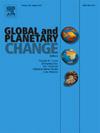Impact of the 1994–1997 temporary decrease in Northern Hemisphere stratospheric methane on the 1990s methane trend
IF 4
1区 地球科学
Q1 GEOGRAPHY, PHYSICAL
引用次数: 0
Abstract
Methane (CH4) ranks as the second most significant anthropogenic greenhouse gas following carbon dioxide (CO2). It originates from a wide range of surface sources and subsequently enters the stratosphere through the tropical tropopause. In line with the observed positive trend in tropospheric CH4, stratospheric CH4 has shown an overall increase in the long-term trend. However, contrary to the continuous increase in tropospheric CH4, stratospheric CH4 exhibits a temporal decrease in the Northern Hemisphere middle and upper stratosphere during short-time periods. This study investigates the causes behind the decreasing trend of stratospheric CH4 in the Northern Hemisphere from 1991 to 2000. We find that the extreme decrease of stratospheric CH4 from July 1994 to May 1997 contributes to the overall decreasing trend of CH4 from 1991 to 2000. This extreme decrease is attributed to the weakened meridional component of the residual circulation. The weakened meridional component attenuates the transport of CH4-rich air from the low-latitude lower stratosphere to the mid-latitude middle and upper stratosphere, leading to the observed decrease in CH4. It is further found that the smallest SST gradient in the North Pacific and adjacent regions from 1980 to 2020 is identified as a significant factor contributing to the weakened residual circulation and the decrease in CH4. Simulations by a chemistry-climate model support the results.
1994-1997年北半球平流层甲烷暂时减少对1990年代甲烷趋势的影响
甲烷(CH4)是仅次于二氧化碳(CO2)的第二大人为温室气体。它起源于广泛的地表来源,随后通过热带对流层顶进入平流层。与观测到的对流层CH4正趋势一致,平流层CH4在长期趋势上总体呈增加趋势。然而,与对流层CH4的持续增加相反,北半球平流层中上层CH4在短时间内呈现出时间上的减少。本研究探讨了1991 - 2000年北半球平流层CH4呈下降趋势的原因。1994年7月至1997年5月平流层CH4的极端减少是导致1991年至2000年CH4总体减少趋势的原因。这种极端的减少是由于剩余环流的经向成分减弱。经向分量减弱减弱了富CH4空气从低纬度平流层向中纬度平流层中上层的输送,导致观测到的CH4减少。1980 - 2020年北太平洋及邻近地区海温梯度最小是导致剩余环流减弱和CH4减少的重要因素。化学-气候模式的模拟支持了这一结果。
本文章由计算机程序翻译,如有差异,请以英文原文为准。
求助全文
约1分钟内获得全文
求助全文
来源期刊

Global and Planetary Change
地学天文-地球科学综合
CiteScore
7.40
自引率
10.30%
发文量
226
审稿时长
63 days
期刊介绍:
The objective of the journal Global and Planetary Change is to provide a multi-disciplinary overview of the processes taking place in the Earth System and involved in planetary change over time. The journal focuses on records of the past and current state of the earth system, and future scenarios , and their link to global environmental change. Regional or process-oriented studies are welcome if they discuss global implications. Topics include, but are not limited to, changes in the dynamics and composition of the atmosphere, oceans and cryosphere, as well as climate change, sea level variation, observations/modelling of Earth processes from deep to (near-)surface and their coupling, global ecology, biogeography and the resilience/thresholds in ecosystems.
Key criteria for the consideration of manuscripts are (a) the relevance for the global scientific community and/or (b) the wider implications for global scale problems, preferably combined with (c) having a significance beyond a single discipline. A clear focus on key processes associated with planetary scale change is strongly encouraged.
Manuscripts can be submitted as either research contributions or as a review article. Every effort should be made towards the presentation of research outcomes in an understandable way for a broad readership.
 求助内容:
求助内容: 应助结果提醒方式:
应助结果提醒方式:


